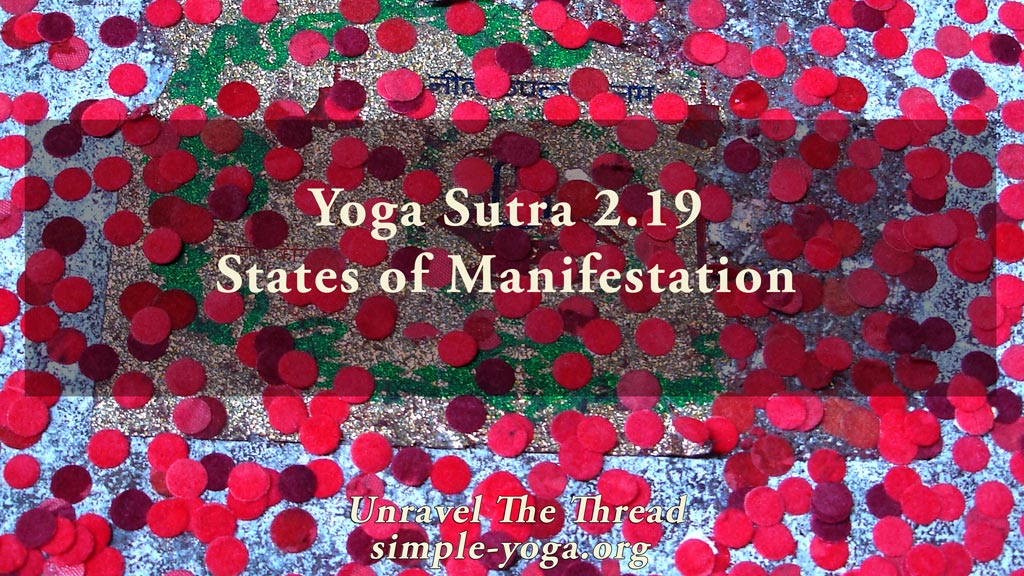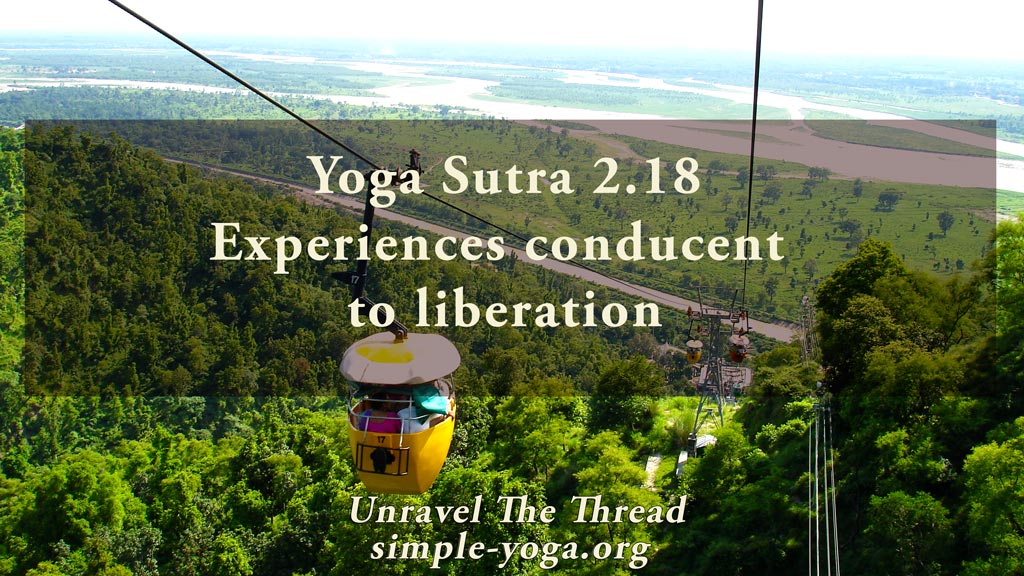
2.17 The cause of suffering
June 14, 2020
2.19 States of manifestation
June 22, 2020
2.17 The cause of suffering
June 14, 2020
2.19 States of manifestation
June 22, 20202.18 Experiences leading to liberation

AWARENESS & EXPERIENCES
2.18 What can be perceived has three attributes: activity (kriya), steadiness (sthiti) and illumination (prakasha). It manifests in the elements and sense organs in order to provide experiences leading to liberation.
As suggested in the previous verse, there are two different aspects interacting, your awareness, which is your sense of being, and what you experience, the actual sensations that make up everything you experience. Suffering is the result of confusing your awareness, the knowing that enables you to experience, with the experiences that you have. It is like confusing your reading glasses with your eyes. This melding causes suffering because of the human tendency to identify with fleeting experiences and their by-products, the desire to retain (raga) or reject (dvesha) them. As a result, confusing awareness with what is experienced will trigger an endless stream of emotions and feelings. Anything and everything that can be experienced is either active (kriya), resting (sthiti) or in a state of equilibrium between activity and inertia (prakasha). Your body is part of what can be experienced. It includes the systems that make up the body as well as the capacity to perceive the endless combinations of the tendencies in nature. When you conflate the experiences with the awareness witnessing them, you may believe that all that there is in life is to chase after experiences, because the experiences provide you with a sense of identity. On the other hand, you can choose to see all experiences as vehicles offering a pathway to deepen your clarity. This clarity leads to liberation from misidentification and its effects. This is the process of vairagya explained in sutras 1.15 and 1.16. This liberation happens, like all processes in yoga and in life, gradually. For instance, sutra 1.15 says that the first step is to release all cravings for externalities. Eventually, says sutra 1.16, awareness settles, not chasing after the senses and remaining anchored in pure awareness. This process happens at the pace each practitioner can handle and in accordance to her level of commitment. There are no shortcuts. You can try to start by freeing yourself from misidentifications and misperceptions, as well as by freeing yourself from adding unnecessary opinions to what is. When free from all opinions, then it is possible to see without the biases created by your opinions, beliefs, likes and dislikes. Then you can experience everything as it is, instead of as you think it is, or should be.
Is it possible to notice how these three attributes of activity, steadiness and balance, are present in every experience you have? Can you notice those attributes as well in your own body? To what extent do these variations in the attributes of experience influence your outlook and attitude? Are your experiences creating more attachments and reactivity, or are they creating greater clarity? Do these questions have a larger underlying theme related to your life purpose?
As usual, one more way of exploring the meaning of this sutra is by chanting it.
You can choose to chant it in its traditional form with some of the words coming together:
2.18 prakāśakriyāsthitiśīlaṃ bhūtendriyātmakaṃ bhogāpavargārthaṃ dṛśyam
प्रकाशक्रियास्थितिशीलं भूतेन्द्रियात्मकं भोगापवर्गार्थं दृश्यम् ॥१८॥
Another option is to chant each word in the sutra individually:
- prakāśa
- kriya
- sthiti
- śīlaṃ
- bhūta
- indriya
- ātmakaṃ
- bhoga
- apavarga
- arthaṃ
- dṛśyam
If you prefer, you may listen to the podcast:
Unravel the thread is now available as a book!
If you find Simple-Yoga.org and Unravel the thread useful, consider supporting my labor with a donation, you may also donate using PayPal or Venmo. Thank you!
